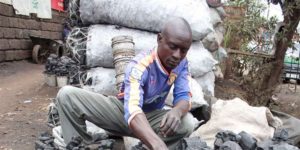
Wa, Upper West Region, Ghana, January 28, 2020//-Burning is still used as a method of clearing away the vegetation,leaving patches of bare land and burnt shrubs.
The trees including shea have developed fire resistance in the form of thick scalely barks. The product of the shea tree (Butyrospermum parking) and the locust bean (parkia olivari) which grow wild, are of exceptional commercial value.
But it appears the fight against poverty in the Northern part of Ghana is a serious mirage or what some will say ‘a wild goose chase’. The very things connected to poverty reduction are being attacked head-on and negatively so,either ignorantly or it is often done with self seeking attitude to benefit few individuals instead of the larger societal interest.

For instance, the Upper West Region with a very poor vegetative cover is the “hub” of charcoal burning activity.
The infantile argument is that the shea tree gives the best results when used in charcoal burning.
And if one visits the Sisaala areas of the region it is most the “notorious” areas noted for charcoal burning in commercial quantities.
With a passing week,one finds truck load of bags of charcoal being carried to the southern half of the country where the least talked about the natural endowment there the better.
I visited Wa East in the Upper West Region (one of the areas with high incidence of poverty) and on my way I found this tricycle loaded with logs of Shea tree cut down from the area.
As a “concerned environmentalist”, I “confronted” this person and asked him why he caused so much damage to the environment by cutting down logs of Shea tree with vast potentials?
Initially “I almost won the battle” with guilt written all over the face of this fellow. But that was pretty short lived as he quickly and in a very smart manner “cooked” up a very nice excuse saying that the shea trees he cut down were “barren” trees, whatever that means.
I probed further to find out what exactly made those cut trees “barren”? He retorted by saying that these were Shea trees on his farm land and that they did not bear fruits for the years he started clearing the land for farming purposes.
Well what would I say? Legitimately with due apology to the current Veep I just thought aloud that:
“You and I were not there”!.
But I wonder the role of the various municipal and district assemblies in the Upper West Region. The worse aspect is that cargo vehicles loaded with bags of charcoal openly pay tolls to the various assemblies before moving out of the district or municipal areas.
But we are often “inundated” with “concerns” by these assemblies to check the cutting down of shea trees in the region. When are we going to see pragmatic action taking place in this regard?

The shea tree grows in the and the rate at which they are being cut down if something is not done practically to save it from extinction the sooner we will live to regret it.
Both Savanna Agricultural Research Institute (SARI) and Cocoa Research Institute of Ghana (CRIG) are making frantic efforts to “tame” the Shea tree but the results has been that very slow we have learnt from sources from these two noble scientific institutions.
In recent years the shea tree has gained importance as an economic crop because of the heavy demand for its butter, both locally and internationally.
In recognition of the need to find substitutes for the rather expensive cocoa products, and to maximize economic exploitation of the vast shea resource in Ghana, the Cocoa Research Institute of Ghana (CRIG) initiated scientific research into the cultivation and processing of shea nuts.
This led to the creation of a subsidiary research station of the CRIG in 1976 at Bole, Northern Ghana. The sole responsibility of this substation is to research into the ecology and biology of the shea tree with the aim of improving its yield.
However, shea trees are being cut for charcoal production which fetches less income when compared to shea butter which is a hot-cake on the international market.
My parting words? A WORD TO THE WISE IS IN THE “NORTH”.
By Seidu Bhomanjo, Broadcast Journalist based in Wa, the Upper West Regional capital


